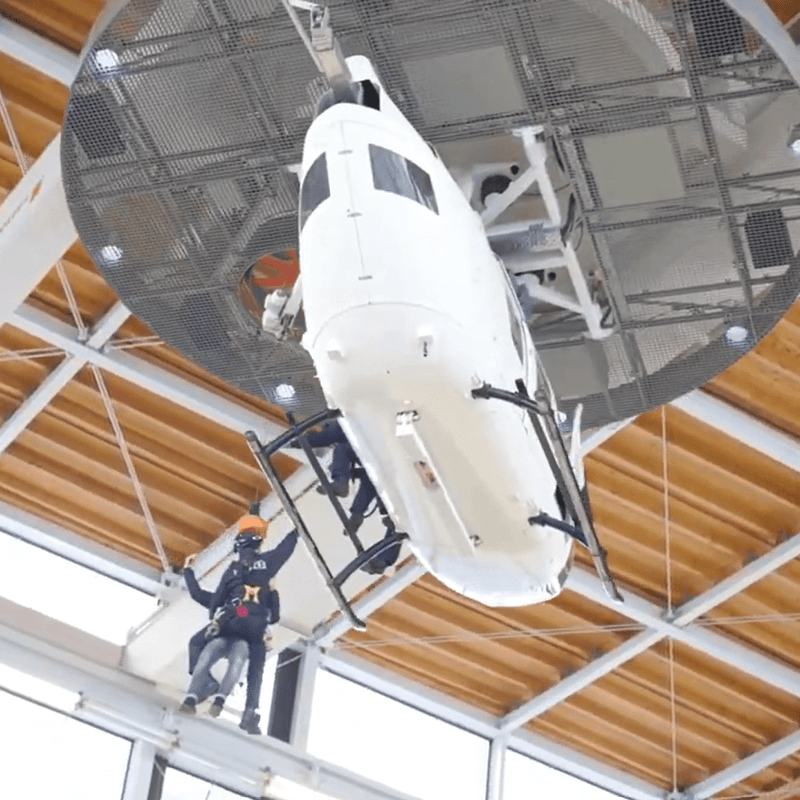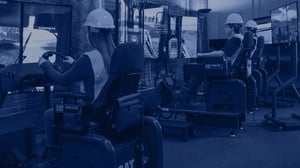Who is AMST Aviation?
Originally founded in 1943 and headquartered in Austria, AMST Aviation is a provider of civil aviation training solutions with clients all across the world. They create tools that provide the conditions necessary to allow clients to both efficiently and effectively gain the skills they need to safely perform their jobs!
One of AMST’s main goals is to encourage the high level of training transfer required to safely execute rescues —the more these crucial skills are practiced in an AMST simulator, the more experienced the trainees will be when their skills are needed in the real world.
AMST also has the safety of everyone involved at the forefront of everything they do. For each client, they study different scenarios to ensure that the training solutions they offer all have the highest possible safety standards for the machine, the user as well as for all trainees involved in the process, regardless of it they’re the ones operating the simulator.
While they offer a full spectrum of civil aviation simulator products, one of their most recent projects was to create the Helicopter Rescue Hoist Trainer — a helicopter used in emergency situations under the most difficult conditions.
About the Hoist Trainer
While a rescue helicopter may seem like an extremely niche type of simulation, there are many situations in which one may be required. For example, Coast Guards, mountain rescue operations, police and special forces, the navy, the army as well as offshore industries such as oil rigs and wind power plants are all examples of organizations and businesses who might call upon a well-trained rescue team.
All of these jobs have one thing in common: they need to be executed in the shortest amount of time, and they’re typically done under the highest amounts of personal stress. When you add in other factors such as harsh locations and weather conditions, having a well-trained crew is absolutely essential to a successful operation!
This is where the Helicopter Rescue Hoist Trainer comes in. Pilots of these types of helicopters (as well as the entire rescue crew) all require an extremely high degree of confidence and experience —and the Hoist Trainer provides this to them in a safe and cost-effective manner.
This high degree of movement allows trainees to simulate all different kinds of conditions and all different kinds of rescue operations while experiencing forces similar to what they’d feel in a real emergency, making it an extremely efficient training tool!
D-BOX & the Simulation Hoist Trainer
AMST recently entrusted D-BOX with the responsibility of adding haptic feedback and vibration for the pilot of the Hoist simulator, with the goal of increasing realism and making rescues safer for everyone involved.
As a result, D-BOX added their renowned haptic system to the pilot’s seat. This allows the pilot to train in a stress-induced environment while performing a rescue, meaning that not only do they learn the best ways to complete a task, but that their bodies will develop the much-needed muscle memory required to complete the task safely and efficiently.
By combining movement with the vibrations and textures created by the haptic feedback, every detail of a rescue can be fully felt and experienced by those taking part.
The haptic feedback in the pilot’s seat also creates additional engagement for the trainee. Everyone trained on the simulator will be able to feel the hum of the helicopter’s engine and propellors, adding to the overall realism of the training!
Benefits of the Hoist Rescue Trainer
While the primary benefit of having a realistic training tool is clear, there are many other benefits that come from training on a realistic haptic simulator other than being more prepared for the real world.
On a macro level, a realistic haptic simulator gives the ability to train for basic procedures (such as quickly loading up the helicopter with equipment) as well as more complicated ones (such as executing a rescue in between two large rock formations), making it a part of a more effective training curriculum. You can also safely perform dangerous rescue operations within a completely safe environment, allowing pilots and other rescuers to achieve a high degree of confidence and experience operating the system in a multitude of conditions.
On a micro level, D-BOX’s haptic technology is backed by science and research to not only train efficiently, but to heighten the user’s level of calmness, enhance memory recall, and to reduce the motion sickness that is frequently associated with simulators of all kinds. This optimizes the training by adding the stimuli needed to enhance a pilot’s psycho-motor reflexes! When you combine all these factors together, the optimal conditions for training transfer are created. These elements of realism also make for a full sense of immersion, meaning that those who are training often forget that they’re in a simulator!
Finally, training in a simulator is extremely cost-efficient: it not only reduces training risks to staff, but it saves countless hours of and expenses of helicopter operating time.
Simulated Training with Haptic Feedback Makes the Real World Safer for All
When it comes to life-or-death emergency scenarios, the best thing you can hope for is a crew that is ready, confident and fully trained to deal with whatever circumstances may come their way. Though it’s a difficult feat, when AMST Aviation created their Helicopter Hoist Rescue Trainer, they knew that they absolutely had to create a training tool that would provide the highest degree of learning necessary.
On top of efficient training, AMST also knows that no matter what type of business their clients run and no matter what sector they’re in, safety is of the utmost priority for everyone involved—including those who will need real rescues after a crew is trained.
This is why the Hoist Rescue Trainer incorporated with D-BOX haptic feedback was created to allow everyone involved in the training process to be trained more efficiently, more safely, and more realistically in a more cost-efficient manner for clients—meaning that more individuals in dangerous situations will have their lives saved by a well-trained crew.


